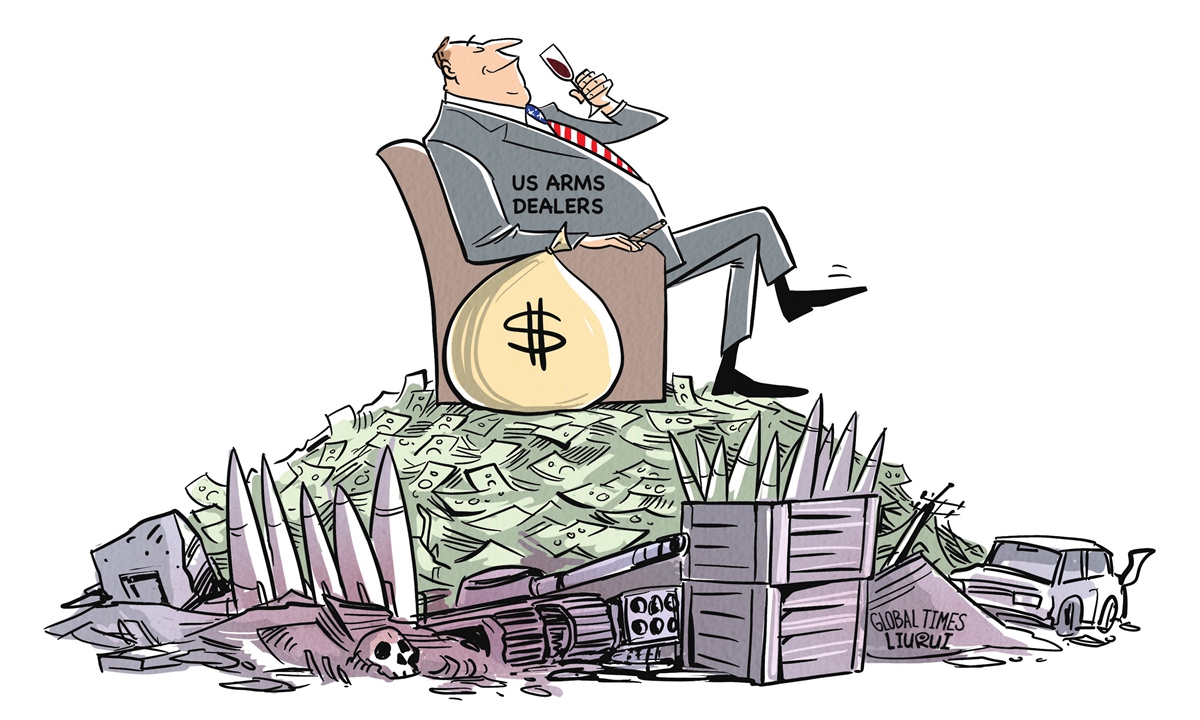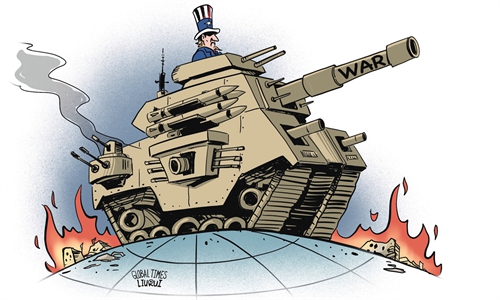Regional conflicts contribute to US arms sales, jobs

Illustration: Liu Rui/GT
Last week, the Council on Foreign Relations unveiled a series of charts that revealed the international support for Ukraine against Russia. These charts meticulously detail the unprecedented aid developed nations have poured into Ukraine.Topping the chart, the US' assistance to Ukraine dwarfs that of any other country, with a staggering $74.3 billion, with over $46.3 billion earmarked for military aid. The global coalition rallying behind Ukraine spans over 40 countries, most of them NATO members and US military allies.
Where does America find the funds to support Ukraine so generously? Well, it all depends on how you crunch the numbers.
The Russia-Ukraine war has sparked an unprecedented arms race among European nations, particularly those in NATO. As they ship off their arsenals, there's a pressing need to replenish. But where does the shopping list lead? Straight to the US. The American military allies are all in the same boat.
US allies such as Poland, Japan, South Korea and China's Taiwan island have become major patrons of American arms.
Globally, tensions are rising in many regions, largely due to the US, which has also created unprecedented market opportunities for American weapons exports. In 2023, the US government facilitated a staggering $81 billion in arms sales, a 56 percent increase from the $52 billion in 2022.
The US has perfected the art of providing weapons with one hand and selling them with the other, turning a profit on both ends of the deal with clarity and precision, while maintaining its vast system of strategic alliances.
Beyond the financial gains, weapon exports play a crucial role in boosting American employment, a perennial concern for every US president. By re-equipping European allies and supporting Ukraine's military efforts, the US defense industry and its related sectors see a significant increase in employment, stimulating the US economy.
Today the aerospace and defense industry supports more than 2.1 million jobs across the US, ranging from high-skilled engineers to assembly line workers and from R&D personnel to administrative support.
The defense industry also creates many indirect job opportunities. It ensures that well-paid defense workers contribute to local economies, leading to job creation in the service sector, such as retail, dining and real estate.
Moreover, the sector is a hotbed for R&D positions, facilitating the transfer and commercialization of technological innovations and further expanding employment opportunities. Many military technologies, like the internet, GPS and drones, have found civilian applications, illustrating this point.
As of early 2023, the US manufacturing sector employed around 12 to 13 million people. If a significant portion of defense industry jobs are considered part of manufacturing, their contribution is notably substantial.
The US has used arms exports as a tool not only to consolidate and expand its strategic alliances, but also to stabilize and develop its dominant position in the international arms market, while at the same time bolstering its economy. On one hand, arms sales have become a key component of the US global strategy, while on the other hand, they serve as a significant pillar of the US empire. This pillar is so deeply intertwined with the employment of ordinary Americans that it cannot be easily separated.
This is a key to our understanding of international relations and the big picture of today's world. How and where the US global strategy goes is invariably linked to the production, development and sale of arms.
One of the differences between US arms sales and those of other major powers is that US arms sales have clearly hostile targets and serve the US in fighting strategically hostile targets.
From this perspective, the US is not going to give up military aid to Ukraine, because that would lead to the disintegration of the US strategic system.
It's a grim reality - more conflict translates to more American jobs. More American jobs mean less hope for peace worldwide. This bizarre linkage is the stark truth of our times.
The author is a senior editor with People's Daily, and currently a senior fellow with the Chongyang Institute for Financial Studies at Renmin University of China. dinggang@globaltimes.com.cn. Follow him on X @dinggangchina



